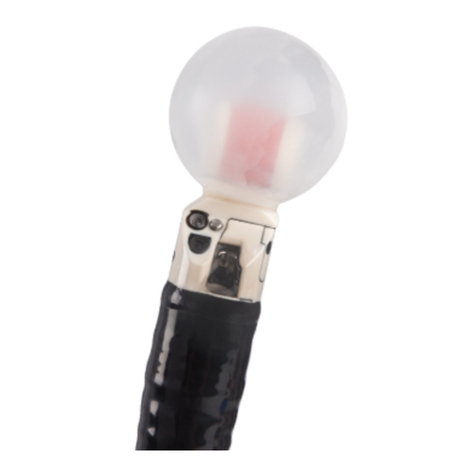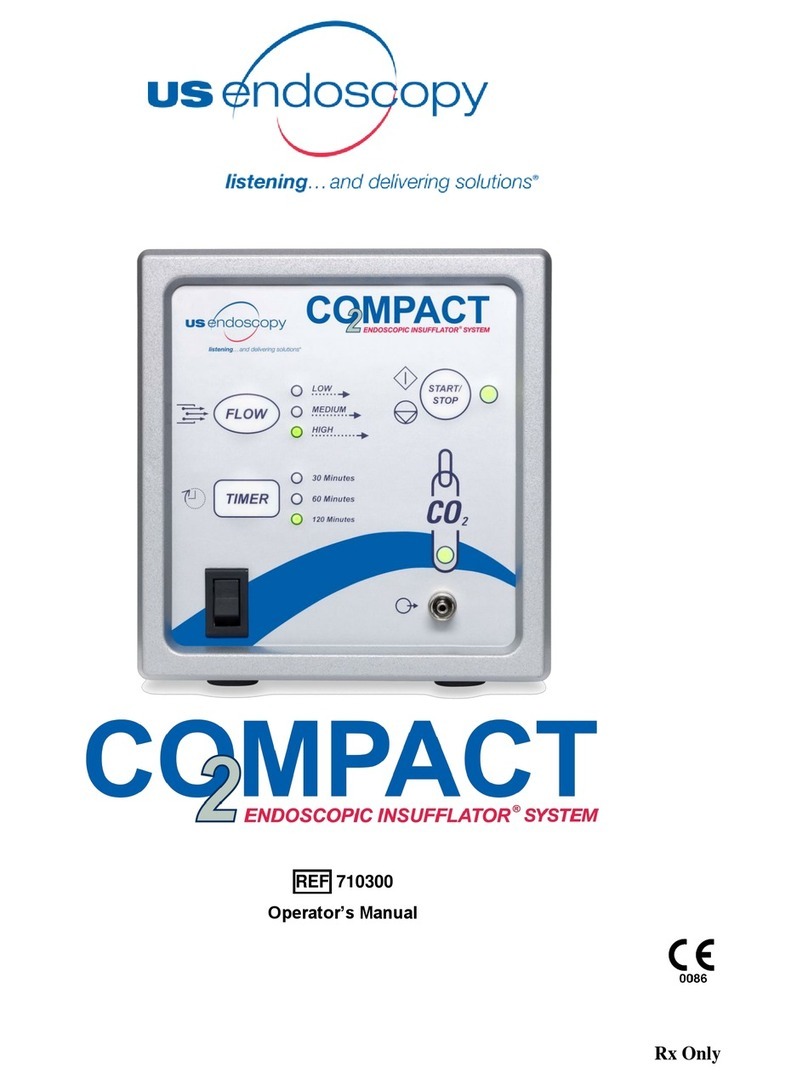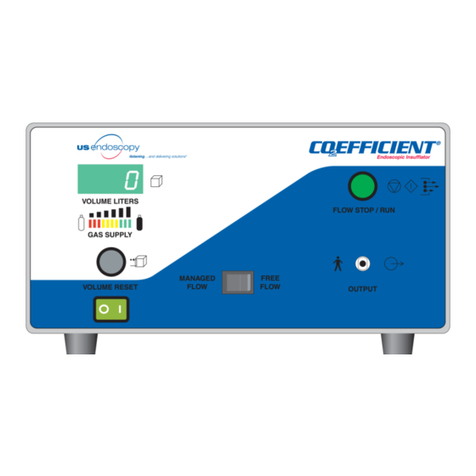00732536 Rev. B 10 of 17
Ikke fremstillet med naturligt latexgummi.
Tilsigtet anvendelse:
US Endoscopy Ultramatrix™ EUS-ballonen er beregnet til udførelse af endoskopiske ultralydsopgaver ved hjælp af ballonmetoden i den øvre eller nedre
mavetarmkanal.
Advarsler og forholdsregler:
•Rådfør dig med den medicinske litteratur vedrørende teknikker, komplikationer og farer forud for udførelsen af enhver EUS-procedure.
•Undersøg ballonen inden anvendelse for at sikre, at den ikke har nogen huller, buler, farveændringer eller andre uregelmæssigheder. Hvis en
uregelmæssighed konstateres, så ANVEND IKKE BALLONEN. Tag en anden ballon og kontakt din lokale produktspecialist.
•Ballonen kan let flænses, så vær påpasselig med skarpe genstande.
•Vær ikke for hårdhændet med og bøj ikke den distale ende af ekkoendoskopet. Der kan opstå skader på instrumentet.
•Fyld ikke vand ind i ballonen, når vandstanden i vandbeholderen er for lav. Ballonen oppumpes eventuelt ikke korrekt.
•Undlad at frakoble vandbeholderen fra endoskopet lige efter, at der er fjernet luftbobler fra ballonen. Dette kan få luftboblerne til at trænge ind i
ballonen igen, når oppumpning atter forsøges.
•Hvis sikring af ballonen foretages med en tråd, så vær varsom med at forhindre okklusion af ekkoendoskopets forsynings- og udsugningsporte til
ballonvandet.
•EUS-ballonen kan briste eller åbne sig, hvis den oppumpes til en diameter større end de anbefalede 20 mm.
•Se venligst anvisningerne nedenfor, hvis ballonen ikke lader sig udtømme for ekstubering fra ekkoendoskopet samt udtagning.
•Forsøg ikke at genanvende, oparbejde, renovere, genfremstille eller gensterilisere dette instrument. US Endoscopy designede ikke dette
instrument til, og det er ikke beregnet til genanvendelse, oparbejdning, renovering, genfremstilling eller gensterilisering. Udførelse af sådanne
aktiviteter på dette medicinske engangsinstrument udgør en sikkerhedsrisiko for patienter (dvs. risiko for instrumentets integritet,
krydskontaminering, infektion).
•EUS-procedurer må kun udføres af personer, der har passende uddannelse samt kendskab til EUS-teknikker.
Kontraindikationer:
•Kontraindikationer omfatter dem, der gælder for enhver endoskopisk procedure, såvel som dem, der gælder for endoskopiske ultralydsprocedurer.
Brugsanvisning:
1. Gør dig selv bekendt med instrumentet og læs alle instruktioner inden klinisk anvendelse.
Afsnit 1 –Montering af ballonen:
Påsætning af ballon med Olympus-ballonapplikator (MAJ-864):
1. Spæd ballonens vandforsyningskanal med de af ekkoendoskopets producent anbefalede midler.
2. Stræk ballonen tre gange ved forsigtigt at trække ballonens to ender fra hinanden og lade dem sammentrækkes igen.
3. Indsæt ballonens forende i applikatoren og stræk ballonens bagerste bånd og sæt det i monteringsrillen.
4. Før ekkoendoskopets distale spids så langt som muligt ind i ballonen (og applikatoren).
5. Rul ballonens bagerste bånd ud af applikatorens rille og ind i ekkoendoskopets proksimale ballonmonteringsrille.
6. Monter forsigtigt ballonens forreste bånd i endoskopets distale monteringsrille.
7. Træk i ballonens omkreds i mellem det forreste og bagerste bånd for at hjælpe dem bedre på plads i monteringsrillerne.
8. Hvis sikring af ballonen foretages med en tråd, så bind den fast inde i ekkoendoskopets monteringsriller.
Montering af ballonen uden applikator:
1. Følg anvisning et og to fra ovenstående afsnit, der beskriver anvendelsen af applikatoren til ballonmontering.
2. Stræk ballonens bagerste bånd lidt åbent for at muliggøre anbringelse på transducerspidsen.
3. Indfør ekkoendoskopets spids i ballonen ved skiftevis at strække og trække ballonen proksimalt.
4. Rul det bagerste bånd ind i ekkoendoskopets proksimale ballonmonteringsrille, når spidsen er helt indført.
5. Monter forsigtigt ballonens forreste bånd i endoskopets monteringsrille.
6. Træk i ballonens omkreds mellem det forreste og bagerste bånd for at hjælpe dem bedre på plads i monteringsrillerne.
7. Hvis sikring af ballonen foretages med en tråd, så bind den fast inde i ekkoendoskopets monteringsriller.
Afsnit 2 –Spædning af ballonen og uddrivning af luft:
1. Med enden af indføringsrøret pegende nedad, tryk luft/vand-ventilen helt ned og fyld ballonen med afluftet vand.
2. Pump ballonen op til cirka 20 mm. Slæk den finger, der trykker på luft/vand-ventilen og tjek, at ballonen er oppumpet.
3. Bekræft, at der ikke er nogen tegn på luftbobler indeni ballonen.
4. Hvis der ikke er nogen luftbobler, så tryk sugeventilen helt ned og fjern alt vandet fra ballonen.
5. Hvis der er luftbobler i ballonen, så gentag trin 1 til 4, indtil alle luftboblerne er fuldstændigt udsuget.
6. Nu er ballonen klar til brug.
Afsnit 3 –Udtagning af ballonen fra ekkoendoskopet:
1. Med overvågning via ultralydsbillede, udtøm ballonen ved at trykke sugeknappen ned og udsuge alt vandet.
a. Hvis ballonen ikke udtømmes, så gå videre med følgende trin:
i. Slå luftstrøm/CO2-regulatoren fra.
ii. Udtag luft/vand-ventilen fra ekkoendoskopet.
iii. Sænk ekkoendoskopets kontrolhoved til lavere end patientens seng.
iv. Vis ballonudtømning på ultralydsskærm.
v. Sæt luft/vand-ventilen på plads igen.
2. Tryk sugeventilen helt ned, mens ekkoendoskopet tages ud fra patienten.
3. Efter ekkoendoskopet er taget ud fra patienten, afmonter forsigtigt ballonen fra transduceren.
Bortskaffelse af produktet:
Efter anvendelse kan dette produkt udgøre en potentiel biologisk fare. Håndter og bortskaf i overensstemmelse med gængs medicinsk praksis og gældende lokale, statslige og
føderale love og bestemmelser.
Udstedelsesdato: Februar 2018
Advarsel:
En udstedelses- eller revisionsdato for disse instruktioner er angivet til oplysning for brugeren. I det tilfælde, at der er gået to år mellem denne dato og produktanvendelsen, skal brugeren
kontakte US Endoscopy for at erfare, om der foreligger yderligere oplysninger.
Listening…and delivering solutions®, designet af US Endoscopy listening…and delivering solutions, og alle mærker markeret med ®eller ™ er registreret hos U.S. Patent and Trademark Office eller
varemærker ejet af US Endoscopy
US Endoscopy, et helejet datterselskab af STERIS Corporation.
Olympus® er et registreret varemærke tilhørende Olympus Optical Co., Ltd.
Fremstillet i USA






























